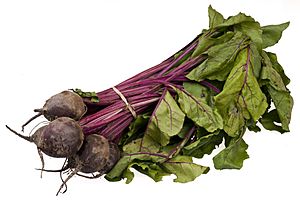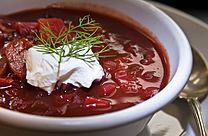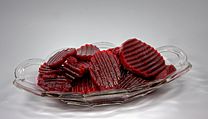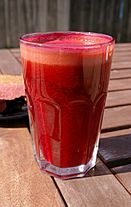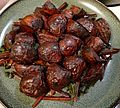Beet facts for kids
Quick facts for kids Beetroot |
|
|---|---|
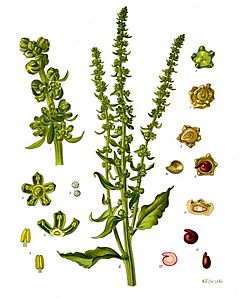 |
|
| Beta vulgaris subsp. vulgaris | |
| Scientific classification | |
| Kingdom: | |
| Division: | |
| Class: | |
| Order: | |
| Family: | |
| Genus: |
Beta
|
| Binomial name | |
| Beta vulgaris |
|
The beetroot is a popular vegetable. It's the main root part of the beet plant. In North America, people often just call it a beet. You might also hear it called table beet, garden beet, red beet, or golden beet.
Beetroot is one of many types of Beta vulgaris plants. These plants are grown because their roots and leaves are good to eat. The leaves are often called beet greens.
Besides being a food, beets are also used as a food coloring. They can even be used as a medicinal plant. Many products, like sugar beet sugar, come from other types of Beta vulgaris plants.
Contents
What's in a Name?
The word Beta is an old Latin name for beets. It might have come from a Celtic word. Around the year 1400, it became bete in Old English.
A Look Back in Time
People have used beetroot for a long time. In the Middle Ages, it was used to help with different health problems. This included issues with digestion and blood.
One old recommendation from Bartolomeo Platina was to eat beetroot with garlic. He thought it would help get rid of "garlic-breath."
In the mid-1800s, beetroot juice was even used to color wine.
Different Kinds of Beets
There are many different types of beets, called cultivars. It usually takes about 55 to 65 days for the root to grow after planting. You can also pick the leaves earlier to eat as greens.
Most beetroots are red or dark red. Some have cool patterns inside when you slice them. Here are a few common types:
- 'Albino': This one has a white root.
- 'Bull's Blood': A classic red beet.
- 'Chioggia': This beet has distinct red and white rings inside.
- 'Cylindra' / 'Formanova': This type has a long, cylinder-shaped root.
- 'Golden Beet' / 'Burpee's Golden': This beet has a bright yellow root.
- 'Ruby Queen': An award-winning red beet from 1957.
Beets on Your Plate
Most often, the deep purple roots of beetroot are eaten. You can boil them, roast them, or eat them raw. They are great on their own or mixed into a salad.
Many beets grown for sale are boiled and packaged. They are also often made into pickles. In Eastern Europe, beet soup, like borscht, is very popular. In Indian cuisine, cooked and spiced beet is a common side dish. Yellow beetroots are grown in smaller amounts, mostly for people to eat at home.
The green, leafy part of the beet plant is also edible. Young leaves can be added raw to salads. Older leaves are usually boiled or steamed. They taste and feel a lot like spinach. When choosing beets, look for firm bulbs and fresh, green leaves.
Beetroot can be boiled or steamed, then peeled. You can eat it warm with or without butter. It's also often cooked, pickled, and eaten cold as a condiment. Raw, shredded beet is also a tasty salad ingredient. Pickled beets are a traditional food in many countries.
A traditional Pennsylvania Dutch dish is pickled beet egg. Hard-boiled eggs are soaked in the liquid from pickled beets. They stay in the fridge until the eggs turn a deep pink-red color.
In Poland and Ukraine, beet is mixed with horseradish to make ćwikła. This is often eaten with cold meats and sandwiches. In Serbia, a similar dish called cvekla is a popular winter salad. It's seasoned with salt and vinegar and served with meat.
Beetroot is also used to make the "red" type of chrain. This is a popular sauce in Ashkenazi Jewish, Hungarian, Polish, Russian, and Ukrainian cooking.
In Australia, a slice of pickled beetroot is often added to hamburgers. It's combined with other toppings to make an "Aussie burger."
Beet juice is also used as a red food colorant. It's especially good in foods with less water, like frozen treats or fruit fillings. The red color, called Betanins, helps make tomato paste, sauces, desserts, jams, ice cream, candies, and breakfast cereals look more vibrant.
You can even make wine from beetroot!
After World War I, there were food shortages in Europe. Some people got sick from eating only beets, which showed how important it is to eat a variety of foods.
- Beetroot as food
-
Borscht, a popular beet soup
-
Finnish rosolli, a salad with beet
-
Chrain with beet, a spicy condiment
What's Inside? (Nutrition)
| Nutritional value per 100 g (3.5 oz) | |
|---|---|
| Energy | 180 kJ (43 kcal) |
|
9.56 g
|
|
| Sugars | 6.76 g |
| Dietary fiber | 2.8 g |
|
0.17 g
|
|
|
Protein
|
1.61 g
|
| Vitamins | Quantity
%DV†
|
| Vitamin A equiv.
beta-Carotene
|
0%
2 μg
0%
20 μg |
| Thiamine (B1) |
3%
0.031 mg |
| Riboflavin (B2) |
3%
0.04 mg |
| Niacin (B3) |
2%
0.334 mg |
| Pantothenic acid (B5) |
3%
0.155 mg |
| Vitamin B6 |
5%
0.067 mg |
| Folate (B9) |
27%
109 μg |
| Vitamin C |
6%
4.9 mg |
| Minerals | Quantity
%DV†
|
| Calcium |
2%
16 mg |
| Iron |
6%
0.8 mg |
| Magnesium |
6%
23 mg |
| Manganese |
16%
0.329 mg |
| Phosphorus |
6%
40 mg |
| Potassium |
11%
325 mg |
| Sodium |
5%
78 mg |
| Zinc |
4%
0.35 mg |
| Other constituents | Quantity |
| Water | 87.58g |
|
Link to USDA Database entry
|
|
| †Percentages estimated using US recommendations for adults. | |
Raw beetroot is mostly water (about 88%). It has about 10% carbohydrates and 2% protein. It has very little fat.
A 100-gram serving of raw beetroot has about 43 Calories. It's a good source of folate, which is important for your body's cells. It also has a fair amount of manganese, which helps your body work properly. Other nutrients are present in smaller amounts.
Early Research on Health Benefits
Some early studies have looked into beetroot juice. In these studies, beetroot juice helped lower blood pressure in animals. This suggests it might help with heart health, but more research is needed for humans.
There's also some evidence that nitrates from beets and other vegetables might help you perform better during endurance exercise. This means it could help you run or bike for longer.
Beets contain compounds called betaines. These might help reduce levels of something called homocysteine in your blood. High levels of homocysteine might be linked to heart problems. However, scientists are still studying if homocysteine itself is harmful or just a sign of other risks.
Other Cool Uses
The red color from beets, called Betanin, is used in factories. It helps make many foods look more appealing. This includes tomato paste, sauces, desserts, jams, ice cream, candies, and breakfast cereals.
Did you know that a chemical called adipic acid is rarely found in nature? But it naturally occurs in beetroot!
Is it Safe?
The red color compound in beets, betanin, isn't broken down by your body. So, if you eat a lot of beets, your urine or stools might temporarily turn a reddish color. This is completely harmless!
To prevent certain chemicals called Nitrosamines from forming in beet juice, ascorbic acid (which is Vitamin C) can be added.
Images for kids


